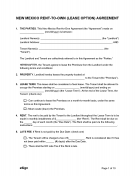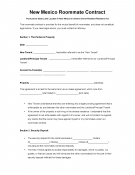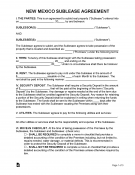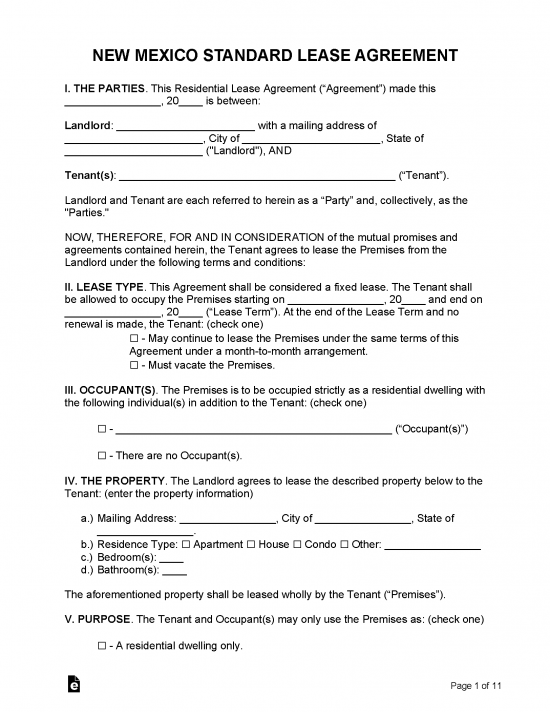New Mexico lease agreements are contracts between landlords and tenants. The agreement will contain the monthly rent, identify which party is responsible for paying specific utilities, and contain policies particular to the property, such as whether pets are permitted. Both the landlord and the tenant should keep a copy of the lease agreement and refer to it to determine their obligations under the lease.
Contents
By Type (6)
- Commercial Lease Agreement
- Month-to-Month Lease Agreement
- Rent-to-Own Lease Agreement
- Roommate Lease Agreement
- Standard Lease Agreement
- Sublease Agreement
Download: Adobe PDF, MS Word, Rich Text Format
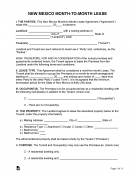 Month-to-Month Lease Agreement
Month-to-Month Lease Agreement
Download: Adobe PDF, MS Word, Rich Text Format
Download: Adobe PDF, MS Word, Rich Text Format
Download: Adobe PDF, MS Word, Rich Text Format
Download: Adobe PDF, MS Word, Rich Text Format
Download: Adobe PDF, MS Word, Rich Text Format
Landlord-Tenant Laws
Statutes – Chapter 47, Article 8, (Uniform Owner-Resident Relations Act)
Required Disclosures (2)
Identity – Landlords must disclose to tenants the names and means of contact of all persons who will be authorized to come on to the property to conduct repairs and post notices. (§ 47-8-19)
Lead-Based Paint Disclosure – Federal law mandates that landlords lease properties with dwelling units built before 1978 disclose to tenants the risks of lead-based paints.
Security Deposit Laws
Maximum Amount ($)
For leases of a term of less than one (1) year, landlords may charge a security deposit of no more than one (1) month’s rent. For leases of a year or more, landlords may charge more than one (1) month’s rent, but must make annual payments to the tenant equivalent to the interest a tenant would receive by putting the amount of the security deposit in a savings and loan account in the state. (§47-8-18)
Returning to Tenant
A landlord must return a security deposit to a tenant within thirty (30) days of the termination of the tenant’s residency. Landlords may retain a portion of the deposit to account for unpaid rent, repair damage to the property beyond wear and tear, or remedy violations of the lease agreement. If the landlord chooses to retain a portion of the deposit, the landlord must provide a written itemization to the tenant, also within thirty (30) days. The landlord should send the deposit and the itemization to the tenant’s last known address. (§47-8-18)
When is Rent Due? (grace period)
New Mexico law does not specify a rent due date or grace period, which means rent is due at the time and place named in the lease agreement.
Eviction Notice (non-payment)
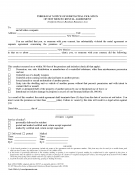 3-Day Notice to Pay or Quit – If a tenant fails to pay rent on the date it is due, a landlord may deliver a notice stating that, unless the full amount is paid within three (3) days of receiving the notice, the landlord may terminate the lease and begin the eviction process. (§ 47-8-33)
3-Day Notice to Pay or Quit – If a tenant fails to pay rent on the date it is due, a landlord may deliver a notice stating that, unless the full amount is paid within three (3) days of receiving the notice, the landlord may terminate the lease and begin the eviction process. (§ 47-8-33)
Download: Adobe PDF
Maximum Fees ($)
Late Rent Penalties
Landlords may charge late fees if the rental agreement states that they are permitted. If a landlord chooses to charge a late fee, he or she may charge no more than 10 percent (10%) of the monthly rent, and must inform the tenant of the late fee no later than the last day of the month after the month for which the fee applies. (§47-8-15)
NSF Checks
New Mexico law on bad checks does not include a statute that applies specifically to rent checks, and does not contain, for any context, statutorily imposed fees for checks bouncing when the tenant did not intend or know there were insufficient funds. (§30-36-6)
Tenant’s Unclaimed Property
In cases of abandonment, if a landlord encounters personal property belonging to a tenant after the termination of a lease agreement, the landlord shall store the property for not less than thirty (30) days. The landlord must provide the tenant that, after at least thirty (30) days from the day of the notice, the property found may be disposed of by the landlord. The landlord should send this notice to the tenant’s last known address or, if this is the unit that has been vacated, at least on more address, such as a tenant’s place of work.
The landlord must include a means of contact, and provide reasonable access to the personal property during the thirty-day time period. If the tenant does not make an attempt to reclaim the property within the time period, the landlord may dispose of the property. In cases of the property found after the scheduled end of a lease agreement, the rules are the same, except for the fact that the landlord need only store the property for fourteen (14) days. In cases of eviction or other forcible ends to the lease agreement, the landlord may dispose of personal property belonging to a past tenant within three (3) days. (§47-8-34.1)

